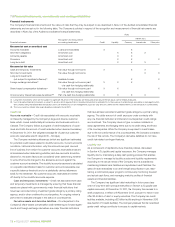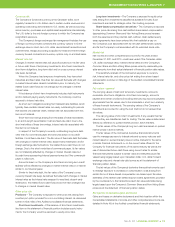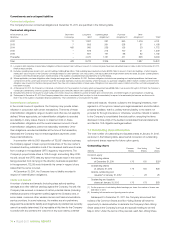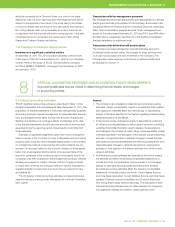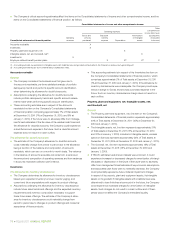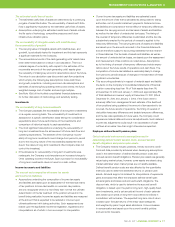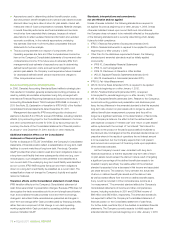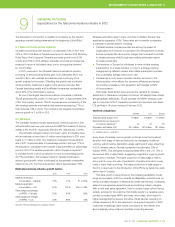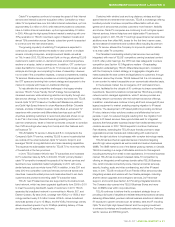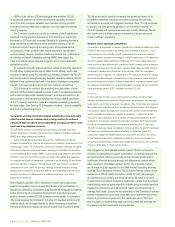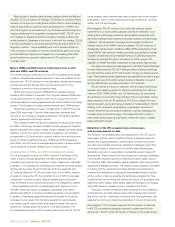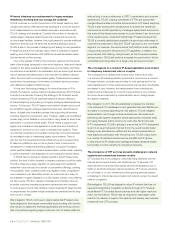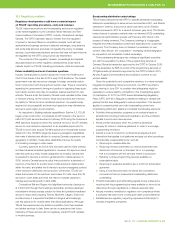Telus 2011 Annual Report Download - page 84
Download and view the complete annual report
Please find page 84 of the 2011 Telus annual report below. You can navigate through the pages in the report by either clicking on the pages listed below, or by using the keyword search tool below to find specific information within the annual report.80 . TELUS 2011 ANNUAL REPORT
It is expected that major mobile platforms will increasingly sell stream-
ing content services in 2012, such as music, TV and video, as consumers
become more comfortable with cloud-based computing, a web-based
way to cost-effectively process, manage and store data. It is expected
that major mobile platforms will transition to supporting cloud-based
services that will allow customers to access both corporate and personal
data
(e.g. photos, streaming video and music) from virtually anywhere,
on multiple devices.
The demand for wireless data services is expected to continue to
grow. Factors related to this increasing demand include: ongoing invest-
ment in faster network technologies such as HSPA+ dual-cell and
LTE that provide a richer user experience and more useful applications;
increasing need for personal connectivity and networking; increasing
affordability and selection of smartphones and Internet-only devices,
including mobile Internet keys and products such as tablets and e-book
readers; intensifying wireless competition; and more affordable data plans.
Increasing data traffic represents a growing challenge to wireless
carriers’ networks and their ability to manage and serve this traffic.
Industry Canada is expected to announce rules for the auction of addi-
tional wireless spectrum, including 700 MHz spectrum, with an auction
expected to be held in late 2012 or early 2013. It is critical that additional
spectrum be made widely available to sustain the ongoing high level
of data growth, and that TELUS be able to acquire spectrum in both
urban and rural markets to support increasing demand.
To better manage anticipated increases in data traffic and to capi-
talize on Canada’s wireless growth opportunity, established Canadian
providers continue to roll out faster, next generation high-speed wireless
networks with increasing capacity. TELUS successfully launched an
extensive next generation network based on HSPA+ technology in 2009,
and enhanced this network in March 2011 with a commercial launch of
HSPA+ dual-cell technology, which offers manufacturer-rated data speeds
of up to 42 Mbps (expected average download speeds of 7 to 14 Mbps
with a compatible device, while actual speed may vary by device being
used, topography and environmental conditions, network congestion,
signal strength and other factors). In addition to the superior capabilities
and higher capacity delivered by HSPA+, this wireless infrastructure
supported TELUS’ migration to LTE, which is rapidly emerging as the
global standard for wireless broadband.
Established companies, such as TELUS, continue to upgrade their
networks and invest in new LTE technology to bring innovative services
and the latest data-capable devices to their customers, while new entrants
have focused on price discounting and basic services in major urban
markets. TELUS launched services on its urban LTE network in February
2012 and expects to expand urban coverage to reach more than 70%
of the Canadian population by the end of 2012. LTE technologies are
expected to deliver manufacturer-rated peak data download speeds of
up to 75 Mbps (typical speeds of 12 to 25 Mbps expected), while at the
same time introducing significant improvements in network capacity
and performance. Any potential roll-out of LTE into rural Canada will be
dependent on the expected Industry Canada spec trum auction of fre-
quencies in the 700 MHz band in late 2012 or early 2013 (see Building
national capabilities in Section 2.2 and Future availability and cost
of wireless spectrum in Section 10.3).
Competitive intensity among established carriers and new entrants
in the wireless market in 2012 is expected to remain high. In 2011, it is
estimated that new entrants WIND Mobile, Mobilicity, Public Mobile and
Videotron collectively gained more than one-third share of new subscribers
in
Canada, with churn rates that are high relative to established providers.
A fifth wireless new entrant, EastLink, is expected to begin offering
services in Atlantic Canada in 2012. Industry analysts expect some
degree of future consolidation among new entrants before the next spec-
trum auction. In contrast, Shaw Communications stopped construc tion
of a conven tional wireless network in Western Canada using its AWS
spectrum acquired in Industry Canada’s 2008 auction. Instead, Shaw is
building metropolitan Wi-Fi networks using unlicensed public spectrum
to extend delivery of its services beyond the home.
To win market share, new entrants are using aggressive price
discounting and unlimited usage plans, adding points of distribution,
adopting a device subsidy approach and introducing smartphones.
The economic sustainability of these discounted, unlimited usage plans,
particularly with respect to data, is doubtful. These new competitors
must also manage various challenges including significant capital require-
ments for network build-out and upgrades, future spectrum costs, upfront
costs for launching and distributing new brands and services, and raising
investment capital. The discount focus and lack of popular smart phones
have been factors behind low reported ARPUs for new entrants.
TELUS, Rogers and Bell have separately branded basic value
services or discount offerings to better position themselves to compete
in this expanding segment. In 2011, TELUS enhanced the value-oriented
offering of its Koodo brand with an expanded range of smartphones
and nationwide calling.
To better compete in the wireless market, TELUS has significantly
intensified its focus on the customer experience. The Company contin ues
to enhance the strong TELUS brand with the evolution of its Clear &
Simple customer approach first launched in late 2009. This includes
significantly reducing the number of rate plans; sending data usage
notifications; offering in-store learning centres; streamlining the device
line-up; facilitating early device upgrades; and offering simplified and
lowered international roaming rates. The Company believes that its
customer-friendly approach has contributed to achieving one of the
lowest churn rates in the Canadian wireless industry.
Given TELUS’ high and growing exposure to wireless (52.5% and 58%,
respectively, of 2011 revenue and EBITDA), strong brands, leading-
edge
value-added products, high-value smartphone growth and new broad-
band network technologies, the Company believes it is well positioned
to benefit from ongoing growth in the Canadian wireless market.
9.3 Wireline
The wireline telecommunications market is expected to remain very
competitive in 2012 with low revenue growth and flat or declining
EBITDA, as legacy services such as local and long distance telephony
are expected to continue declining due to consumer migration to email
and messaging services, as well as to wireless and voice over IP (VoIP)
services. Canada’s four major cable-TV com panies had an installed base
of approximately 3.9 million telephony subscribers at the end of 2011,
or a national consumer market share of approximately 32%, up 1% from
2010. Other non-facilities-based competitors also offer local and long
distance VoIP services and resell high-speed Internet solutions. This
competition, along with technological substitution such as to wireless,
continue to erode TELUS’ residential NALs and associated local and long
distance revenues. In 2011, TELUS’ total NALs decreased by 3.9% or
146,000, comparing favourably to 2010 (when TELUS NALs decreased
by 5.7% or 227,000), as well as to North American peers. Improvement in
2011 was partly due to enhanced retention and loyalty in response to
multiple service offerings and bundling with Optik TV and Optik
High Speed Internet.




